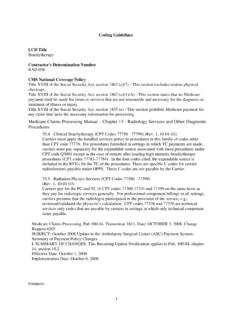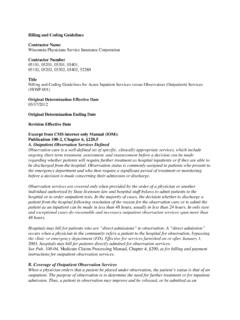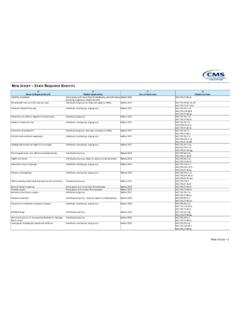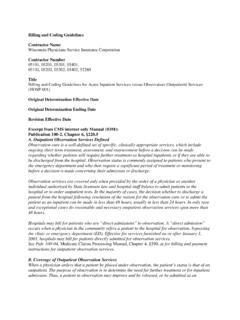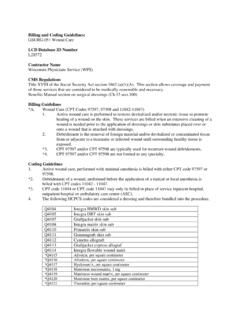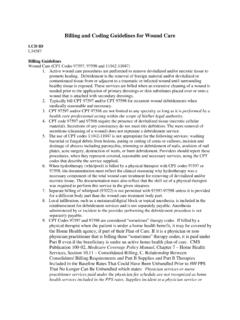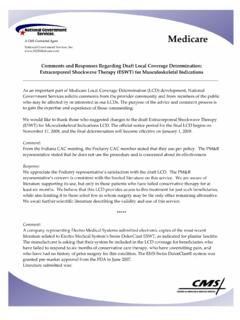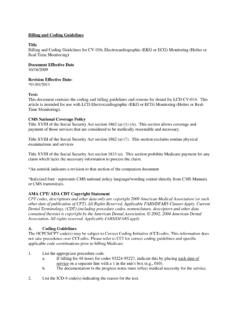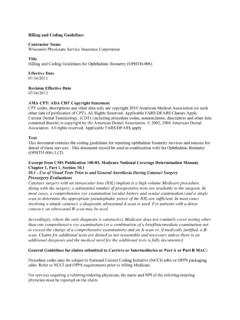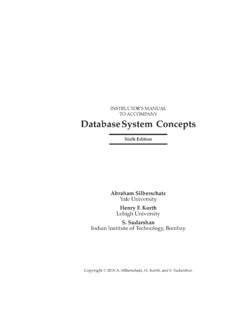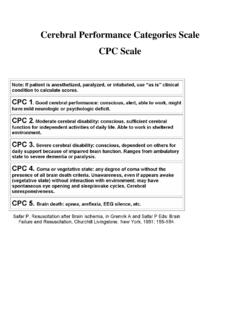Transcription of Billing and Coding Guidelines for Radiation Oncology ...
1 Billing and Coding Guidelines for Radiation Oncology Including Intensity Modulated Radiation Therapy (IMRT) LCD Determination ID Number L34652 Guidelines Reasons for Denial Services performed for diagnoses not listed as covered in this policy or for excessive frequency will be denied as not medically necessary. Frequency is considered excessive when services are performed more frequently than generally accepted by peers and the reason for additional services is not justified by documentation. Indications not listed as covered under the Coverage Indications, Limitations, and/or Medical Necessity section will be denied as not medically necessary.
2 When a hospital inpatient is transported to a freestanding facility for therapy, the technical component of the Radiation Oncology services cannot be paid to the freestanding facility. Unless the patient is discharged from the hospital and treated at the freestanding facility as an outpatient, this payment will be denied. Appeals for denied claims must be accompanied by that portion of the patient s medical record that documents the reason for the service. It is not necessary to provide the complete medical record. Note: All documentation must be specific to the patient being treated or the claim will be denied.
3 Billing and Coding A. Treatment planning is a one-time charge per course of therapy. Billing for multiple treatment plans for a single course of treatment is not allowed. This is a professional service only and the physician is responsible for all the technical aspects of the treatment planning process. 1. CPT code 77261 is used when the volume of interest to be treated is clearly defined and easily encompasses the tumor while excluding normal tissue and structures. Simple planning requires a single treatment area of interest encompassed in a single port or simple parallel opposed ports with simple or no blocking.
4 2. CPT code 77262 is used when there is a moderate level of planning difficulty involved. It requires three (3) or more converging ports, two (2) separate treatment areas, multiple blocks, or special time dose constraints. 3. CPT code 77263 is uses when complex treatment planning is involved. Complex planning requires highly complex blocking, custom shielding blocks, tangential ports, special wedges or compensators, three (3) or more separate treatment areas, rotational or special beam considerations, or combination of therapeutic modalities.
5 Complex planning includes interpretation of special testing, tumor localization, treatment volume determination, treatment time/dosage determination, choice of treatment modality, determination of number and size of treatment ports, selection of appropriate treatment devices, and other procedures. B. Following treatment planning, simulation is used to actually direct the treatment beams to the specific volume of interest. Simulation may be carried out on a dedicated conventional stimulator or CT scanner, Radiation therapy treatment unit ( , linear accelerator), or using diagnostic imaging equipment ( , fluoroscopy, CT, MR).
6 The complexity of the simulation is based on number of ports, volumes of interest, and the inclusion and type of treatment devices. The number of films taken per treatment, the modality from which the images for simulation are obtained, and the use of fluoroscopy are not determinants of complexity. Portal changes based on unsatisfactory initial simulation(s) are not reported as additional simulations. Additional simulations may be necessary during a treatment in order to account for changes in port size, boost dose, or tumor volume. However, minor changes in port size without changes in beam or without clinical justification do not warrant an additional charge or a higher level of complexity.
7 inclusion of treatment devices in the simulation process typically increases the complexity. Simulation without the inclusion of devices or with any pre-made devices ( , blocks, immobilization) is considered simple. The addition of custom immobilization devices or tangential ports is an indicator of complex level of simulation. The typical course of Radiation therapy will require between one and three simulations. However, no more than one simulation should be reported on any given day. Frequency in excess of three simulations should be supported by documentation in the medical record.
8 1. Use CPT code 77280 to report simple simulation of a single treatment area. A treatment area is a contiguous anatomic location that will be treated with Radiation therapy. Generally, this includes the primary tumor organ or the resection bed and the draining lymph node chains. 2. Use CPT code 77285 to report intermediate simulation for two (2) separate treatment areas. 3. Use CPT code 77290 to report complex simulation for three (3) or more treatment areas, or any number of treatment areas if any of the following are involved: particle, rotation or arc therapy; complex blocking; custom shielding blocks; brachytherapy simulation; hyperthermia probe, verification; any use of contrast materials.
9 4. Use CPT code 77293 as an add-on code for respiratory motion management simulation. It describes the physician work and resources involved in acquiring a respiratory correlated or 4-D Ct simulation study for conformal planning. Add-on codes are never performed independently and must be reported in addition to the primary procedure. This code must be reported with the primary procedure of either 77295 or 77301 for the same date of service, even though the work may take place over many days. C. Use CPT code 77295 to report 3-dimensional radiothreapy plan, including dose-volume histogram.
10 This code also includes those procedures done in preparation for use of coplanar therapy beams and, therefore, CPT codes 77280, 77285, and 77290 are not separately payable on the same date. It also includes the work done for a teletherapy isodose plan (CPT codes 77306-77307) and accordingly, codes 77306-77307 should not be billed separately. Code 77295 may be billed once per treatment course per treatment volume. In those uncommon circumstances, where there is a substantial change in either patient anatomy or tumor conformation and where a second CT dataset is required to produce an accurate, efficacious and safe cone-down plan, a second 77295 charge may be appropriate.
